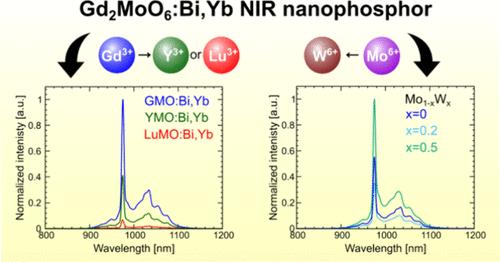当前位置:
X-MOL 学术
›
J. Phys. Chem. C
›
论文详情
Our official English website, www.x-mol.net, welcomes your
feedback! (Note: you will need to create a separate account there.)
Luminescence Tuning of NIR Luminescence Nanophosphor Bi3+/Yb3+-Doped RE2MoO6 (RE = Gd, Y, and Lu) and Gd2Mo1–xWxO6
The Journal of Physical Chemistry C ( IF 3.3 ) Pub Date : 2024-11-15 , DOI: 10.1021/acs.jpcc.4c04814 Taisei Hangai, Takuya Hasegawa, Jian Xu, Takayuki Nakanishi, Takashi Takeda, Tomoyo Goto, Yasushi Sato, Ayahisa Okawa, Shu Yin
The Journal of Physical Chemistry C ( IF 3.3 ) Pub Date : 2024-11-15 , DOI: 10.1021/acs.jpcc.4c04814 Taisei Hangai, Takuya Hasegawa, Jian Xu, Takayuki Nakanishi, Takashi Takeda, Tomoyo Goto, Yasushi Sato, Ayahisa Okawa, Shu Yin

|
Near-infrared nanophosphors have attracted attention due to their wide application fields, including component analysis, bioimaging, and spectral converters of sunlight for crystalline silicon solar cells (c-Si). Yb3+ ions exhibit near-infrared (NIR) luminescence at around 1000 nm, which is consistent with the first biological window and the maximum responsivity range of c-Si. Therefore, we focused on and successfully synthesized Bi3+/Yb3+-doped NIR luminescence nanophosphors, RE2MoO6:Bi3+,Yb3+ (RE=Gd, Y, and Lu) and Gd2Mo1–xWxO6:Bi3+,Yb3+ (x = 0–0.5), utilizing a solvothermal reaction process. All samples exhibit NIR luminescence of Yb3+ ions under ultra-violet (UV) light excitation and broadband excitation due to the charge transfer transition between the O 2p/Bi 6s and Mo 4d or W 5d orbitals, indicated by their optical properties of photoluminescence (PL), PL excitation (PLE), and reflectance spectra. Furthermore, to evaluate the contribution of the Gd2MoO6:Bi,Yb (GMO:Bi,Yb) nanophosphor to the conversion efficiency of c-Si, a phosphor-converted film was made using dimethylpolysiloxane (PDMS) and the GMO:Bi,Yb nanophosphor. The results showed that the conversion efficiency of c-Si with the PDMS/GMO:Bi,Yb film is higher than that of c-Si with the PDMS-only film. Based on these results, the utilization of down-shifting nanophosphors is able to enhance the conversion efficiency of c-Si, which could be beneficial in addressing future energy challenges.
中文翻译:

近红外发光纳米荧光粉 Bi3+/Yb3+ 掺杂的 RE2MoO6 (RE = Gd、Y 和 Lu) 和 Gd2Mo1–xWxO6 的发光调谐
近红外纳米荧光粉因其广泛的应用领域而受到关注,包括晶体硅太阳能电池 (c-Si) 的成分分析、生物成像和太阳光光谱转换器。Yb3+ 离子在 1000 nm 左右表现出近红外 (NIR) 发光,这与 c-Si 的第一个生物窗口和最大响应范围一致。因此,我们专注于并成功合成了 Bi3+/Yb3+ 掺杂的 NIR 发光纳米荧光粉,RE2MoO6:Bi3+,Yb3+(RE=Gd、Y 和 Lu)和 Gd2Mo1–xWxO6:Bi3+,Yb3+ (x = 0–0.5),利用溶剂热反应过程。由于 O 2p/Bi 6s 和 Mo 4d 或 W 5d 轨道之间的电荷转移转变,所有样品在紫外 (UV) 光激发和宽带激发下都表现出 Yb3+ 离子的 NIR 发光,这由它们的光致发光 (PL)、PL 激发 (PLE) 和反射光谱的光学特性表示。此外,为了评估 Gd2MoO6:Bi,Yb (GMO:Bi,Yb) 纳米荧光粉对 c-Si 转换效率的贡献,使用二甲基聚硅氧烷 (PDMS) 和 GMO:Bi,Yb 纳米荧光粉制成了荧光粉转换膜。结果表明,使用 PDMS/GMO:Bi,Yb 薄膜的 c-Si 转换效率高于使用 PDMS 单纯薄膜的 c-Si。基于这些结果,利用下移纳米荧光粉能够提高 c-Si 的转换效率,这可能有利于应对未来的能源挑战。
更新日期:2024-11-16
中文翻译:

近红外发光纳米荧光粉 Bi3+/Yb3+ 掺杂的 RE2MoO6 (RE = Gd、Y 和 Lu) 和 Gd2Mo1–xWxO6 的发光调谐
近红外纳米荧光粉因其广泛的应用领域而受到关注,包括晶体硅太阳能电池 (c-Si) 的成分分析、生物成像和太阳光光谱转换器。Yb3+ 离子在 1000 nm 左右表现出近红外 (NIR) 发光,这与 c-Si 的第一个生物窗口和最大响应范围一致。因此,我们专注于并成功合成了 Bi3+/Yb3+ 掺杂的 NIR 发光纳米荧光粉,RE2MoO6:Bi3+,Yb3+(RE=Gd、Y 和 Lu)和 Gd2Mo1–xWxO6:Bi3+,Yb3+ (x = 0–0.5),利用溶剂热反应过程。由于 O 2p/Bi 6s 和 Mo 4d 或 W 5d 轨道之间的电荷转移转变,所有样品在紫外 (UV) 光激发和宽带激发下都表现出 Yb3+ 离子的 NIR 发光,这由它们的光致发光 (PL)、PL 激发 (PLE) 和反射光谱的光学特性表示。此外,为了评估 Gd2MoO6:Bi,Yb (GMO:Bi,Yb) 纳米荧光粉对 c-Si 转换效率的贡献,使用二甲基聚硅氧烷 (PDMS) 和 GMO:Bi,Yb 纳米荧光粉制成了荧光粉转换膜。结果表明,使用 PDMS/GMO:Bi,Yb 薄膜的 c-Si 转换效率高于使用 PDMS 单纯薄膜的 c-Si。基于这些结果,利用下移纳米荧光粉能够提高 c-Si 的转换效率,这可能有利于应对未来的能源挑战。


















































 京公网安备 11010802027423号
京公网安备 11010802027423号